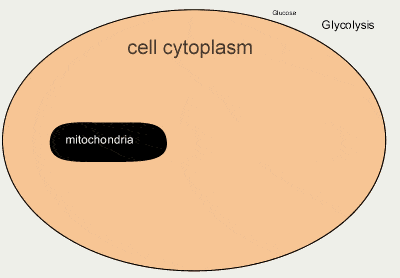Glycolysis
Aerobic and anaerobic cellular respiration.
Glycolysis is the breakdown of glucose into two pyruvate molecules with the net gain of 2 ATP molecules. This takes place in the cytoplasm of the cells whether oxygen is present or not and is the first step to both aerobic and anaerobic respiration.
What happens next is dependent on oxygen. If oxygen is present the pyruvate molecules enter the mitochondria and are oxidised to carbon dioxide and water in a process called aerobic respiration. If oxygen is absent, as is the case with intense exercise such as the 100m sprint, the pyruvate become oxidised to lactic acid. As the athlete recovers and oxygen becomes available lactic acid is converted back into pyruvate and oxidised in the mitochondria, as shown on the right. Some of the lactic acid formed can also be removed by the blood.
Glycolysis and anaerobic respiration are almost the same thing. That is both occur in the cytoplasm and neither requires oxygen. The difference however, is that glycolysis produces pyruvic acid as an end product, while anaerobic respiration goes a step further and converts the pyruvic acid into either lactic acid or, as in the case with yeast, ethanol and carbon dioxide.
When an athlete explodes off the starting block, blood vessels to the muscle have yet to dilate fully and blood supply to the stressed muscle is limited. Oxygen demand outstrips oxygen supply anaerobic energy systems such as creatine phosphate and glycolysis take over supplying energy to the muscle.

Glycolysis involves the partial breakdown of glucose into a molecule called pyruvate. In the absence of oxygen (anaerobic respiration), pyruvate is reduced to lactic acid, by the enzyme lactate dehydrogenase, in animals. This provides most of the energy demands during intense exercise of less than two minutes. When oxygen is available, aerobic cellular respiration proceeds slower and the pyruvate formed is used in oxidative pathways, inside the mitochondria, to produce carbon dioxide, water and more ATP. In fact, aerobic respiration produces 18 times more ATP than glycolysis and continues to provide energy when extended moderate exercise is necessary. Most people believe that aerobic exercise is a good way to burn fat, but carbohydrates (glucose) accounts for up to 40-60% of energy output during moderate aerobic exercise. The process of glycolysis begins as soon as muscle contraction starts.
When lactic acid builds up cell metabolism is turned off, as a protective measure, and is one of the causes of muscle failure during strenuous exercise. Since the major source of glucose for glycolysis is glycogen, further intense exercise, in the short term, without replenishing the muscle glycogen is impossible.
Below is the chemical reaction of aerobic respiration. Glucose is oxidised completely to carbon dioxide and water with the release of energy. For every glucose molecule oxidised in aerobic respiration a net of 36-38 ATP molecules are gained.
C6H12O6 + 6O2 => 6C02 + 6H20 + energy
Anaerobic respiration occurs in the absence of oxygen and the overall equation for the reaction occurring in some plant cells or yeast,is given below.
Glucose ——> ethanol + carbon dioxide
C6H12O6 ——> 2C2H5OH + 2CO2 + energy

In animal cells anaerobic respiration yields lactic acid according to the equation below.
Glucose ——> ethanol + carbon dioxide
C6H12O6 ——> 2C3H6O3 + energy